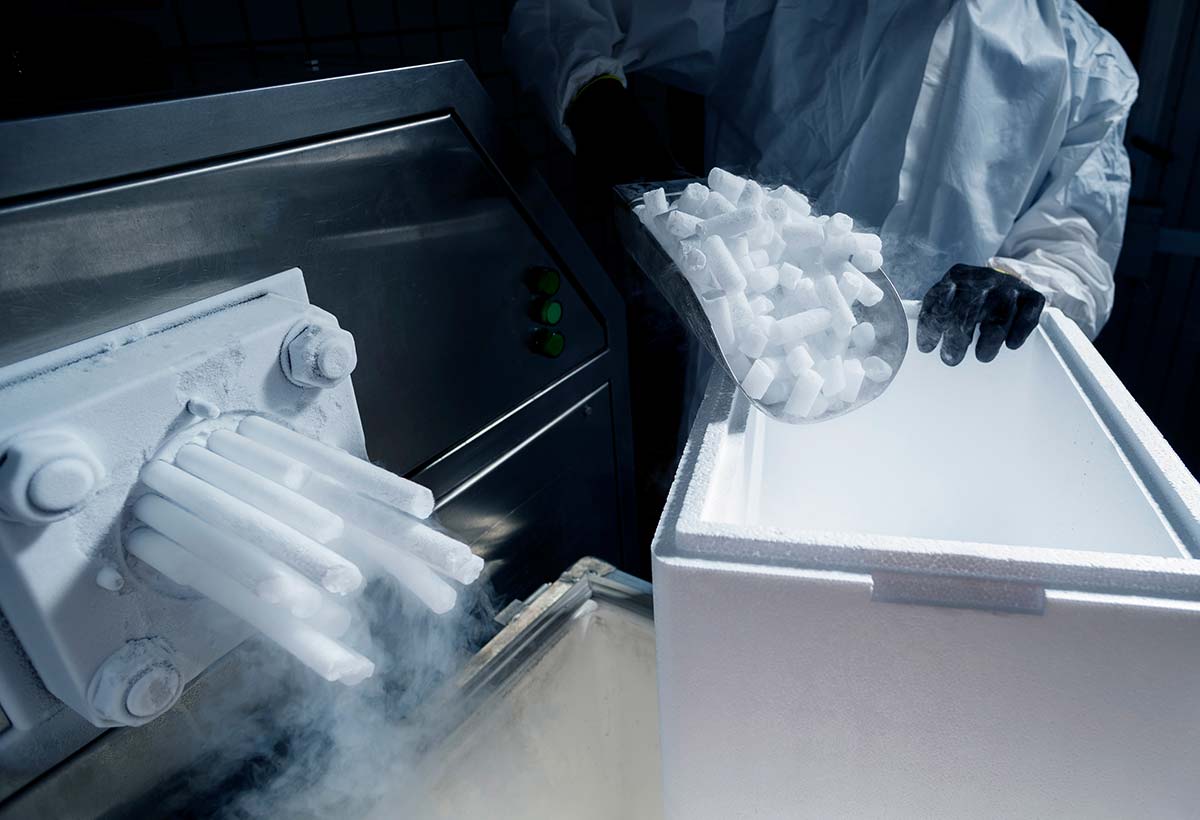Wednesday was V-day; the day long awaited. The first Pfizer vaccination was made. An important step to get us out of the corona crisis. Pfizer’s vaccine must be stored and transported at -70 degrees Celsius. This is a complicated logistical operation. Dry ice is the most practical means of ensuring this constant low temperature. But, what exactly is dry ice? How does it work and what are the dangers of this substance? Jannie van Vliet, lecturer in Hazardous Substances Legislation explains.
Dry ice – or carbon dioxide snow – is the solid form of carbon dioxide. It is mainly used for refrigeration; foodstuffs, as well as vaccines. In addition, we know this substance from theater technology: it can be used to create a smoke curtain or low-hanging mist.
How is dry ice made?
A bit of physics: In the production of dry ice, CO2 gas is first liquefied under pressure and then squeezed through small openings. This creates white, very cold carbon dioxide snow. This dry ice has a temperature of -79 degrees Celsius. Does the temperature get above -79 degrees? Then the dry ice sublimates. This is different from melting. Dry ice passes directly from solid to gas. No moisture is left behind. Hence the name dry ice.
Because of the dangers of suffocation, burns and package collapse, the packing and transportation of dry ice is regulated.
Sublimation does not stop
The advice is to purchase dry ice as soon as possible before use. Indeed, you cannot stop sublimation; only slow it down. Either way, you will lose between 2.5 and 5 kg of dry ice per day. That means you obtain between 1.35 m3 and 2.7 m3 of carbon dioxide gas, which displaces oxygen in a room. We’ll come back to that in the dangers of dry ice.

Store
Dry ice should be stored in a well-insulated container. A thick Styrofoam cooler is sufficient to store dry ice for a long time. It is important, however, that the storage container is not completely airtight. When dry ice turns into gas, it needs space to escape. If the gas cannot escape, the danger is that pressure will build up, causing the package to collapse.
Hazards
Besides the danger of pressure buildup, the substance dry ice has other dangers. When dry ice sublimates, it creates a suffocating gas. This is because carbon dioxide gas is heavier and pushes all oxygen out of a room. Proper ventilation of areas where dry ice is stored and used is therefore essential. In addition, dry ice has the constant temperature of -79 degrees Celsius. That means it can cause frostbite to the skin and eyes, resulting in burns. Therefore, always wear gloves and safety glasses when in contact with dry ice.
When dry ice sublimates, it creates a suffocating gas. Proper ventilation of areas where dry ice is stored and used is essential.
Rules to transportation
Because of the dangers of suffocation, burns and package collapse, the packing and transportation of dry ice is regulated. Packaging must be able to withstand very low temperatures, prevent the release of gas and prevent pressure build-up. Packagings must be clearly and legibly marked with the UN number and ADR substance name, supplemented by ‘as refrigerant’ or ‘as conditioning agent’, for example: UN 1845 Dry ice, as a refrigerant.
Vehicles and containers carrying packages containing dry ice must carry a special warning sign in a place where it is easily seen by persons opening or wishing to enter the vehicle or container.

Unpackaged dry ice
Dry ice used in unpackaged form must not come into direct contact with the metal structure of the transport unit. Measures should be taken to ensure adequate insulation by providing a minimum separation of 30 mm between the dry ice and the transport unit, for example with a material that has low thermal conductivity, such as wood.
Language(s) used
Marking and inscriptions on packages, vehicles and containers and the information in the transport document must be in the language of the country of dispatch. If not French, German or English, it must also be in French, German or English. For transportation within the Netherlands, the Dutch language is sufficient.
Help document for employers
Our specialists created a handy help document for employers and employees who work with dry ice. A handy, clear document with the most important risks and actions regarding working with dry ice. Download the help document here.
In conclusion
Finally, here are the facts and figures about dry ice:
- Extremely cold: -79C
- Carbon dioxide in solid form
- Suitable for preserving food and vaccines
- Suitable for creating fog in a theatrical performance
- Suitable for creating culinary dishes at the molecular level
- Choking hazard – ventilate well!
- Risk of burns – wear safety glasses and gloves







